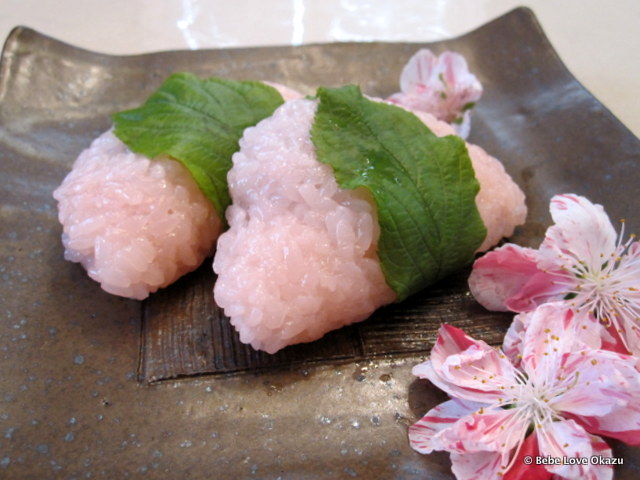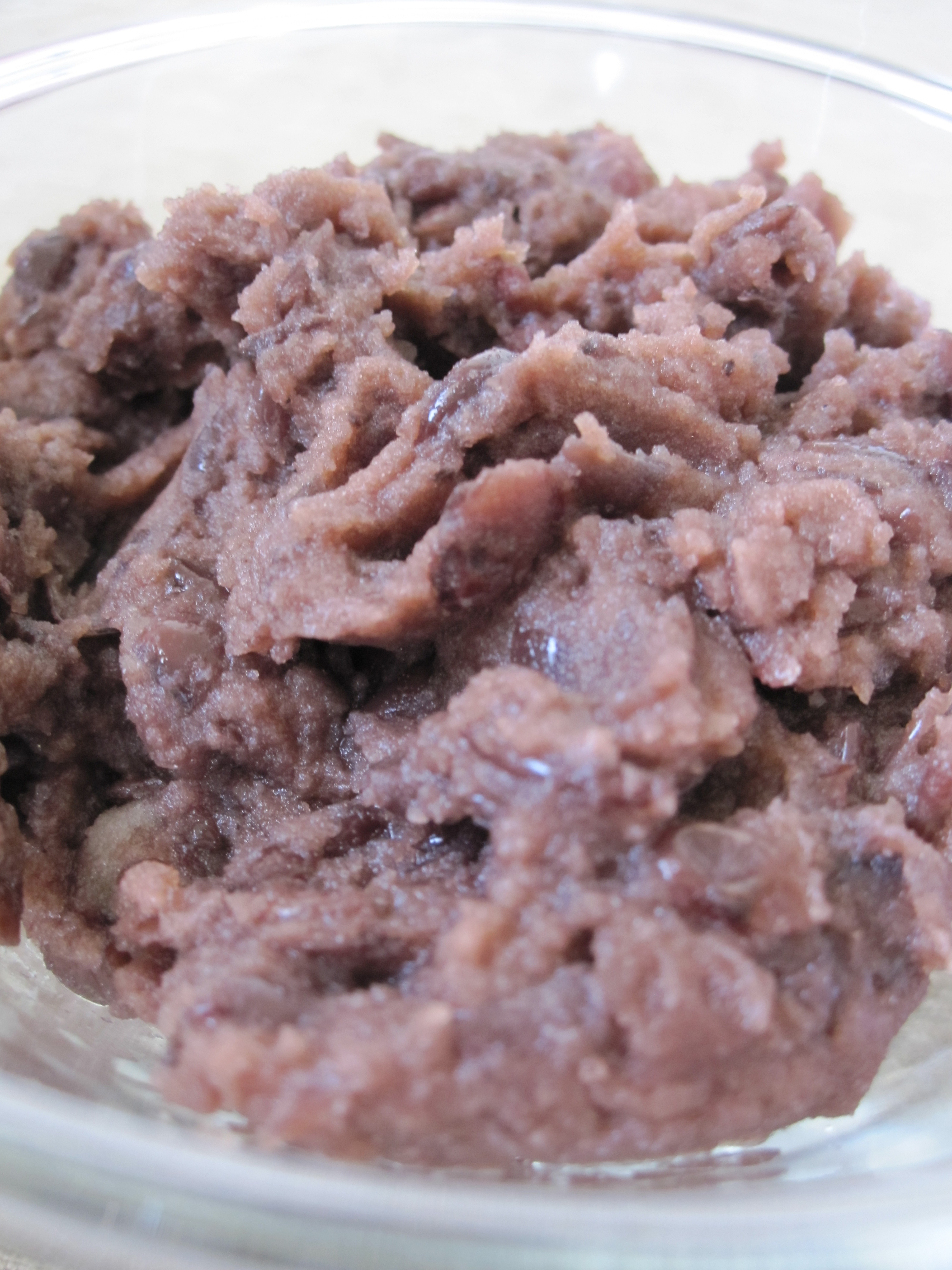Sakura Mochi (Sweet Rice) & Hinamatsuri (Japanese Girls Day) 2010

For Bebe E’s first Hinamatsuri I decided to make Sakura Mochi for dessert. This is a traditional Japanese confectionery or wagashi that is traditionally eaten on Hinamatsuri.
This was my first attempt at making mochi (rice cake). As a teen I used to help out every December at our temple’s mochitsuki (mochi pounding ceremony), but I was only responsible for shaping the mochi into little round patties. That wasn’t going to help me much with this endeavor.
Photo Above:
Sakura Mochi decorated with sakura (cherry blossom flowers) picked from a tree at Stoner Park in WLA. I don’t think I was supposed to pick the flowers but I only took about six of them. :)
I turned to my mom for help, but she told me that she’d never made Sakura Mochi before. She said she always bought it in its ready-to-eat form. I even asked several of my mom’s friends but they too had never made it!
Hmmm… so, I did what any other modern day girl would do. I did a Google search and landed at About.com. Haha. I know, this is not very traditional Japanese, but I modified the mochi recipe I found there, used my mom’s Koshi-An (sweet red bean paste) recipe, and with a little help from S-san’s sakura (cherry blossom) tree, I ended up with a pretty good dessert!
Mom’s Koshian Filling
- 2 cups azuki beans (red beans)
- 1 1/3 cups sugar

- 1 teaspoon salt
- 4 1/2 cups water
In a large bowl, soak azuki beans in water overnight. Rinse beans and drain.
Transfer beans to a large pot, add water, bring to a boil.
Turn down the heat to medium and simmer beans for about 10 minutes. Skim foam and any residue that floats to the top of the pot.
Turn down the heat to low and simmer the azuki beans for about 1 1/2 hours, or until softened. Stir beans occasionally to make sure that the beans don’t stick to the bottom of the pan and burn.
Most of the liquid should boil off, but the azuki beans will have a slightly watery texture. Don’t worry if it looks too watery. As the koshi-an filling cools, this water will be absorbed into the beans, and you will end up with a thick, creamy filling.
Add sugar and salt into the koshi-an mixture and stir constantly for about 5 minutes until the sugar is dissolved. Don’t leave the stove unattended because your koshi-an will burn! Turn off heat.
Sakura Mochi
When I was researching Sakura Mochi recipes, most all used Mochiko (sweet rice flour) to make smooth mochi, as opposed to mochi that resembled sticky rice. The thing is, at the supermarket I’ve always seen textured Sakura Mochi where you could actually see the rice grains. I thought this was traditional. I’m not really sure which is more authentic for Sakura Mochi – smooth mochi versus textured rice-grainy mochi.
To make mochi, typically mochigome (glutinous rice / sweet rice) is cooked, then pounded with a large wooden mallet to make smooth rice cakes. Ummm, if you know me in person… you know that I would have a hard time pounding rice, or even carrying a 10 pound bag of rice, so manual labor is OUT.
Per mom’s suggestion, I decided to use mochigome, which literally looks like sticky white rice, and make textured mochi in my rice cooker. I modified a recipe found on About.com and came up with the following.
- 3 cups sweet rice (glutenous rice)
- 2 drops red food coloring
- 2/3 cups sugar
- 3 cups water according to the measurement guideline of the rice cooker(Makes approximately 16 – 18 Sakura Mochi)

Wash rice until water runs clear and drain. Let drained rice stand for 30 minutes. Meanwhile, dissolve sugar in about 1 cup of water in microwave for 1-2 minutes and let cool.
Add 2 drops of red food coloring to the sugar mixture. This will make the rice pink. It’s important to have PINK mochi for Girl’s Day. :) Add the pink sugar mixture to the rice and fill the rice cooker with 3 cups of water according to the measurements on the rice cooker.
SIDEBAR: I use a Zojirushi Fuzzy Logic rice cooker that I bought on sale at Marukai supermarket. I love this thing because it has a timer that you can set to have your rice cooked in 1 to 13 hours. This is perfect for when you want to soak your rice. It also has a warmer.
Let the rice soak in the pink sugar mixture and water for 1 hour before cooking. Allowing the rice to soak in the water will help to ensure that the cooked rice grains are soft and not hard in the center. We do not want al dente mochi rice!
After the rice cooks, don’t open the rice cooker and let the rice steam for 30 minutes. I kept the rice cooker on warming mode until I was ready to make the mochi and then unplugged the rice cooker to bring down the temperature of the mochi so it was easier to handle.
TIP: It’s easier to work with mochi if it is warm because it’s pliable. I learned the hard way that if you don’t work quickly and let the mochi cool too much, its really difficult to shape.
Oh, for those of you that don’t mind a little manual labor, please feel free to smash the cooked rice a little bit with the shamoji (rice paddle) after its done steaming. I didn’t do this, and honestly, my Sakura Mochi came out great.

I used a good size piece of saran wrap to cover the palm of my hand so that the mochi wouldn’t stick to my hand. (I also use this technique when making onigiri or rice balls.) Take about 2-3 tablespoons of mochi and spread on your palm in an oblong shape about 2 1/2 inches long. Be careful not to spread the mochi too thin because then your koshi-an filling will break through the mochi when you are wrapping it.
Place a round 1 teaspoon scoop of koshi-an filling near the bottom center of your oblong mochi and then fold over the top half of the oblong and seal it by pressing the ends closed. Voila! Sakura mochi complete! Well, almost…
Pickled Sakura (Cherry Blossom) Leaf
This was a challenge.
Me: “Mom, where do I buy pickled sakura no happa (cherry blossom leaf)?” Mom in Japanese: “EH?!? I’ve never seen THAT at Mitsuwa.”
Me: “Are you sure? It’s probably sold in a jar or a can or something. What about Marukai?” Mom in Japanese: “EHHHH?!?? I’ve never seen THAT at Marukai. Haven’t seen it at Nijiya or Safe and Save either.”
Me: “Hmmm. Well, where do you suppose people buy those?” Mom in Japanese: “People just buy it already wrapped on the ready-to-eat Sakura Mochi. People don’t want to buy JUST the sakura leaves.”
Ok, mom didn’t really have a solution for me. So once again, I Googled.
Yet I couldn’t find a pickled sakura leaf recipe, nor could I find anyone online who actually sold them pickled. Then, I came across a suggestion to use canned pickled grape leaves as a substitute for sakura leaf for the mochi. I decided against using this because I thought the flavor of the grape leaves would alter the taste of the Sakura Mochi.
Then my mom suggested calling my BFF’s (best-friend-forever whom I’ve been friends with since the age of 6) mom who she thought had a sakura tree in their backyard. They didn’t.

BFF’s mom suggested calling S-san who indeed had a sakura tree but it only had a few baby leaves. That was enough, so my mom, bebe E, and I got in the car and went over to S-san’s house in WLA.
The tree was beautiful!!! The flowers were a gorgeous shade of dark pink and green buds that would eventually become cherries were abundant. The leaves were small in comparison to the larger leaves typically seen on the Sakura Mochi at the supermarket but that was OK. S-san encouraged us to pick as many baby leaves as we needed. We took just a handful and in return we delivered some of my Sakura Mochi decorated with her leaves to say ‘thank you’. :)
Oh, and I learned from S-san that the sakura tree is barren with only branches until the flowers start to bloom, then the leaves finally show up after the flowers have bloomed. I never knew that!
The baby sakura leaves have a beautiful sweet fragrance and their bright green color were a wonderful compliment to my mochi. I blanched the leaves in boiling water for 3 minutes but they were not palatable.
I am planning to return to S-san’s house in a few more weeks to pick sakura leaves that are still young but bigger. By the time I go leaf-picking I need to find a recipe for pickling these things for next year’s Hinamatsuri. Help!


23 Comments